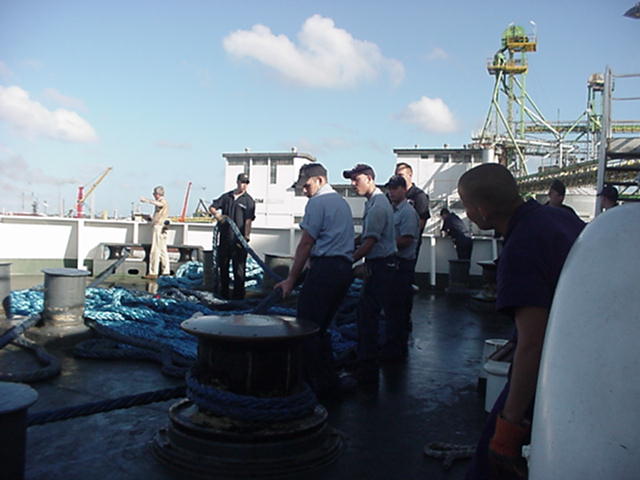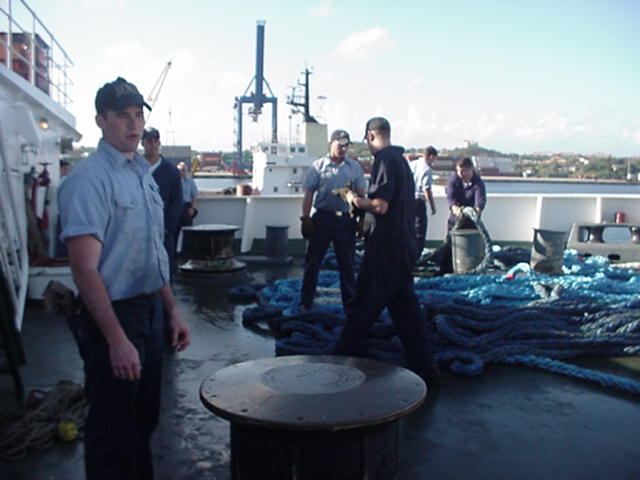
| February 2001 | ||||||
| Sun | Mon | Tue | Wed | Thu | Fri | Sat |
| 1 | 2 | 3 | ||||
| 4 | 5 | 6 | 7 | 8 | 9 | 10 |
| 11 | 12 | 13 | 14 | 15 | 16 | 17 |
| 18 | 19 | 20 | 21 | 22 | 23 | 24 |
| 25 | 26 | 27 | 28 | |||
At 0800 Atlantic Standard Time, the Training Ship Empire State was underway and heading for St. Thomas in the U.S. Virgin Islands. She was located at 14 degrees and 14 minutes North Latitude and 070 degrees and 35 minutes West Longitude.(Curacao was 100 nautical miles to the south east) She was steering course 341 degrees true at a speed of 13 knots. The weather was pleasant; air temperature 80 degrees and water temperature 78 degrees Fahrenheit; skies were partly cloudy; winds were from the East at 06 knots; barometric pressure was 1016 millibars. Seas were gently rolling at 2 to 4 feet. The depth of water beneath the keel was 3584 meters.
CAPTAIN'S LOG
There's time enough, but none to spare.
Charles W. Chesnutt, 1901
Oh, the wonderful sensation, at sea and underway, swelling gently upward and sloping obliquely down, riding easterly seas pushed onward by the relentless winter trades. She wanders mischievously, to port at first, and then suddenly to starboard, playfully testing the compass. She rushes farther on and then retreats, all the while moving effortlessly northward atop the passing crests. We had barely grown accustomed to this perpetual motion that is life at sea when we were cast ashore to flounder, but that time has passed. Now, we have returned to the soothing symphony of the wind driven wave and the warm caress of ocean breeze. We ride the strong winds of tropical winter as did the conquering Spaniards in a hostile time gone by, and all is right with our world...
Notwithstanding the unforeseen opportunities of the past days, the Officers and Cadets never missed a beat and have expertly adapted situational uncertainties to meet all required training goals. While some freshman were somewhat short changed on time at the helm, actually steering the ship at sea, and others were prevented from fully enjoying the "heat" while standing next to the steaming boiler, all will understand and appreciate each operation. We will make time in the engine room and on the bridge for them.
You will recall that the cadets worked miracles with our distilling plant and those repairs are proving fortunate, indeed. Our extended stay at Admiral Bryon Wharf depleted our freshwater reserves. The newly repaired units are producing more water than ever and we will quickly make up for any shortfall. That is particularly good news; the laundry is in full swing and the showers are removing that sweet engine room "glow". I frequently remind the readers that difficulty presents opportunity and that is true here, as well. Nothing teaches the importance of freshwater conservation at sea like "water hours" in port. Those following our voyage in the classrooms might practice strict water conservation for a day; the experience may be surprising.
Well, once again, I must stop chasing the mouse and go to work. We are glad to be here. See you tomorrow.
CADET COMMENT
Departure from Curacao!! Cadet 3/C Angela Abbott

Finally, we leave Curacao, our Port of Call for 12 days. We spent nine extra days on that little island. Looking back, now some eight hours from it, I can say that it was good to us, and we left on good terms with it.
The deck cadets worked very hard to ensure our safe and speedy departure and when all lines were free of the dock, it was as if a huge weight had been lifted from everyone's shoulders. I watched the cadets who were working the bowlines for most of the departure. Twelve cadets from all classes synchronized their work to successfully house the anchor and use a huge winch to bring in two bowlines. One bowline was out on our port side the other on our starboard and four cadets heaved and tugged each line to bring them aboard.
Captain Dalton talked the fourth class through the process of bringing the anchor aboard. 1/C Helling recruited two freshmen to help with the lines. Although the 4/C Cadets aren't nearly as salty as the seniors, they are trained to take orders and to listen carefully to directions so they proved to be of great help.
I left the bow after we were clear up forward and headed aft, where twelve more cadets clearing the stern. There, four cadets operated the winch and an officer gave the commands. A senior shouted out proper procedures.
A tug made up between the bow and the stern, and assisted in pulling Empire State away from the dock. The Harbor Pilot was aboard and he communicated between the bridge and the tug throughout the maneuver.
Until this morning, I never really thought about all the communication involved in getting the ship away from the dock. It never seemed like that big of a deal. There was a lot of communication between the bow and the stern, the ship and the shore, the ship and the tug, the bridge and the engine room, the bridge and the bow, and the bridge and the stern. All of the movements and actions at these points had to be perfectly timed in order to move the ship properly. The cadets and officers make these transitions smooth and easy for everyone involved.

I overheard some cadets talking, and they are happy to be off the dock. It means that we are one step closer to home and any motion in that direction is good. We are free of Curacao or truer still Curacao is free of us. The open water is calling so here we come St. Thomas!
We miss our families and friends!! So, from everyone here to everyone there: we miss you so much...we can't wait to see you!! Smooth Sailing from here on in!
QUESTIONS FOR Thursday 1 FEBRUARY
MATH:
Several cadets went scuba diving in Curacao. The water depth was measured at 70 feet of seawater. They dived to a depth of 66 feet. What was the absolute pressure PSIA at that depth? What pressure reading would the divers read on a pressure gauge (PSIG)? Why the difference? Pressure per foot of seawater is .445 psig.
SCIENCE:
Cadets routinely measure atmospheric pressure (density of the earth's atmosphere). What three factors affect the density?
GEOGRAPHY:
The Empire State is visiting St. Thomas Island. The Island is part of what Island group?
HISTORY:
When did the United States purchase St. Thomas and from whom?
ANSWERS FOR Wednesday 31 January
MATH:
40 fry will measure more than one decimeter in length.
40 x 3 x .039 = 4.68 inches U. S. equivalent
40 x 3mm = 120MM or 12 Centimeters
1DM = 10 CM
1mm = .039 inches
SCIENCE:
Three factors that affect temperature are latitude, elevation, and presence of ocean currents.
GEOGRAPHY:
Punxsutawney, PA; Groundhog Day.
HISTORY:
Since 1887, the members of the Punxsutawney, PA Groundhog Club in Pennsylvania have watched for the first appearance of Punxsutawney Phil, a notorious weather predicting ground hog (woodchuck).